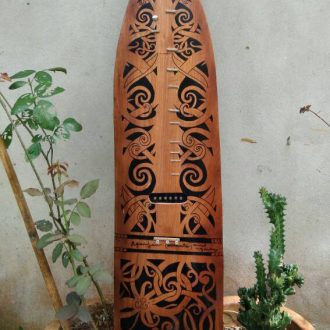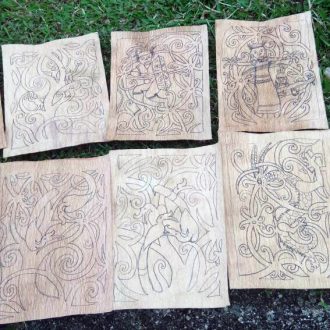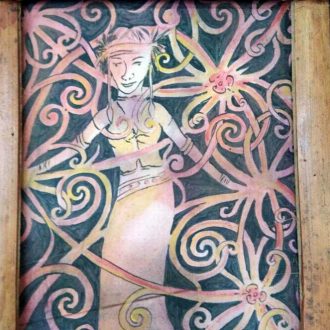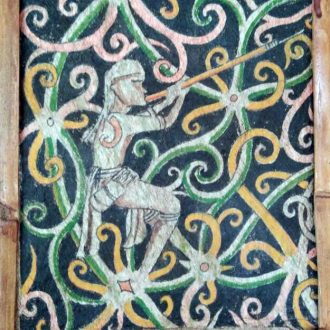Mathew Ngau Jau, is a 66-year-old Kenyah Ngorek, a Bornean indigenous ethnic group from Long Semiyang in Sarawak, Malaysia. He is a professional Sape’ performer, maker and teacher, and is one of the few community-recognised authority figures on the instrument. To his community, he’s endearingly known as “the Keeper of Kenyah Ngorek Songs”.
In 2015, Mathew was granted the title of “Malaysia’s Living National Heritage” by the Ministry of Tourism and Culture. Today, he continues his efforts in preserving the Sape’ and the traditions of the Kenyah culture through various initiatives and platforms.
In line with this, Mathew will be teaching the Sape’ to both children and adults (ages 9 to 12, and 13 and older respectively) at the Yayasan Sime Darby Arts Festival (YSDAF) this 18 & 19 August 2018 at The Kuala Lumpur Performing Arts Centre (klpac).
What is a Sape’? How does Mathew craft them?
Legend has it that Adau wood, from which the Sape’ is made of, has magical qualities. As the story goes, a dying wife told her husband that she could hear music coming from an Adau tree. Distraught, her husband then carved out a Sape’ from the tree and begun playing songs to her. While listening to the songs, the wife rose to her feet and began dancing. This is why, traditionally, the Sape’ is used as part of healing rituals and ceremonies.
Today, Adau wood is scarcely available in Kuching, where Mathew is based. Instead, Mathew uses Ba’ok wood, which is more accessible, to craft a Sape’. He’ll take around four to five months from start to finish.
After the trunks of the Ba’ok tree are harvested, they are left to dry for a while, before being shaped into a Sape’. Mathew also includes other finishes in his work, such as painting them or installing a guitar pick-up.
How did Mathew start learning the Sape’? What did he do to be a better performer?
Ever since Mathew was a child, the Sape’ was an integral instrument in his life. His relatives and elders of his village played it often, Mathew remembers.
—————————–
“Our folk songs are passed down to us, so the traditional songs are ingrained within us. I kept learning by listening, watching and practicing.”
Mathew Ngau Jau
—————————–
Mathew eventually had the opportunity to play with the late Tusau Padan and the late Uchau Bilong, who were considered masters of the time. They performed together at the Rainforest World Music Festival under the name “Lan e Tuyang”, and that was when he truly refined his skills.
Since then, interest in and popularity of the Sape’ began to grow among festival-goers, and people started to ask Mathew to teach them how to play it — so he did!
Above: Mathew is a master in making hand-crafted Sape’s and tree-bark paintings.
How does Mathew hope to preserve the Sape’s legacy?
Today, many Sape’ artistes are beginning to adapt their instruments to fit into contemporary music settings. The instrument now comes in various shapes and sizes, and even comes with guitar pick-ups for performing in concerts and festivals.
However, that’s not enough to ensure the Sape’s longevity. Mathew believes that, in order for its legacy to carry on, people will need to understand the cultural significance of the Sape’ — its role in traditional folk songs, and in the Kenyah community itself.
To Mathew, the Sape’ is a “gift” passed down to him through generations. It’s then his role and duty to pass it on and to protect these traditions, just like how he received and learnt it.
—————————–
“We need to care for these gifts — things that are not ours. It belongs to our ancestors and most importantly, it must continue to belong to our community for generations to come.”
Mathew Ngau Jau
—————————–
What can Malaysians do to ensure that their traditions are preserved for future generations?
All it takes is for you to be open to those who are different from you, and to embrace them, Mathew says. This way, we encourage people to be proud of their own cultural identities.
Mathew recalls a time in the 1960s and 1970s when Kenyah women and men started moving into towns to study, they were ridiculed and stared at because of their elongated earlobes held by brass weights or their rounded haircuts. This prompted some of them to cut off their earlobes, or change their hairstyles which caused the tradition to wither away. Mathew learnt something important from this, and he explains the lesson perfectly:
—————————–
“Be proud of your roots, your cultural identity. Care. Learn about it. Embrace it. You have so many things and tools at your disposal today to be able to play an active role in learning and practicing aspects of it. That way, you can contribute to the preservation of it, no matter how big or small.”
Mathew Ngau Jau
—————————–
To find out more about Mathew and the work he does, visit mathewngaujau.com.
Mathew Ngau Jau is represented by The Tuyang Initiative, a social enterprise that works closely with Dayak (indigenous) communities with focus on inclusive development and promotion of cultural heritage talents, products & services for their chance at sustainable alternative income and preservation of tradition, arts and culture. For more info, visit thetuyang.com.



